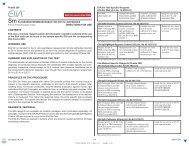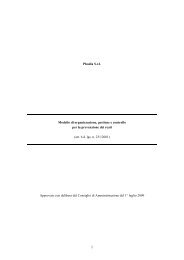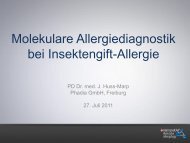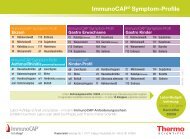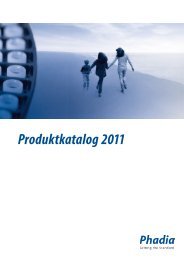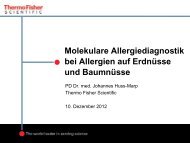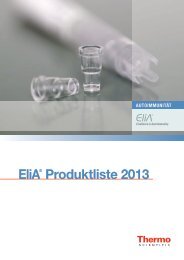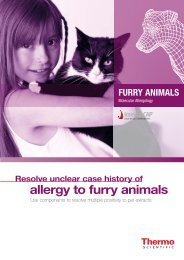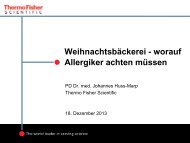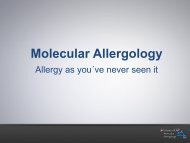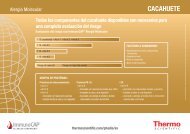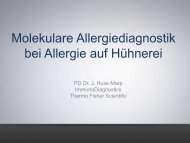Instrucciones de uso Kit de ensayo ImmunoCAP ISAC IgG4 - Phadia
Instrucciones de uso Kit de ensayo ImmunoCAP ISAC IgG4 - Phadia
Instrucciones de uso Kit de ensayo ImmunoCAP ISAC IgG4 - Phadia
Create successful ePaper yourself
Turn your PDF publications into a flip-book with our unique Google optimized e-Paper software.
20-01-04-1-ES<br />
<strong>Instrucciones</strong> <strong>de</strong> <strong>uso</strong><br />
<strong>Kit</strong> <strong>de</strong> <strong>ensayo</strong> <strong>ImmunoCAP</strong> <strong>ISAC</strong> ® <strong>IgG4</strong>
Tra<strong>de</strong>marks/Marques/Varemerker/Warenzeichen/Varemaerker/<br />
Marchi <strong>de</strong>spositati/Marchas registradas/Varumärken/Marcas registradas<br />
Los nombres siguientes son marcas registradas propiedad <strong>de</strong> <strong>Phadia</strong> AB:<br />
<strong>ImmunoCAP</strong><br />
Los nombres siguientes son marcas registradas propiedad <strong>de</strong><br />
<strong>Phadia</strong> Multiplexing Diagnostics GmbH:<br />
<strong>ISAC</strong><br />
Los nombres siguientes son marcas comerciales propiedad <strong>de</strong> CapitalBio Corporation:<br />
LuxScan<br />
Bibliografía<br />
Consulte la página 12<br />
Desarrollado por:<br />
<strong>Phadia</strong> Multiplexing Diagnostics GmbH, Viena, Austria, y<br />
<strong>Phadia</strong> AB, Uppsala, Suecia<br />
Publicado en febrero <strong>de</strong> 2009<br />
© <strong>Phadia</strong> AB, Uppsala, Suecia<br />
Página 2
USO PREVISTO<br />
<strong>ImmunoCAP</strong> <strong>ISAC</strong> <strong>IgG4</strong> es un <strong>ensayo</strong> in vitro para la <strong>de</strong>terminación semi-cuantitativa <strong>de</strong> los<br />
anticuerpos <strong>IgG4</strong> específicos en suero o plasma humano. Está concebido para su <strong>uso</strong> en el<br />
diagnóstico in vitro junto con otros resultados clínicos y <strong>de</strong>be utilizarse en laboratorios clínicos y en<br />
laboratorios médicos.<br />
RESUMEN Y EXPLICACIÓN DEL TEST<br />
El cálculo <strong>de</strong> los anticuerpos <strong>IgG4</strong> específicos ha servido para efectuar estudios clínicos sobre<br />
diversas patologías alérgicas (1-13). A<strong>de</strong>más, los anticuerpos <strong>IgG4</strong> específicos pue<strong>de</strong>n ser<br />
biomarcadores <strong>de</strong> exposición al antígeno en los individuos no alérgicos (14). En la monitorización<br />
<strong>de</strong> la inmunoterapia con inhalantes y venenos himenópteros generalmente se observa un aumento<br />
<strong>de</strong> los niveles <strong>de</strong> <strong>IgG4</strong> específicos, aunque no se ha <strong>de</strong>mostrado una correlación <strong>de</strong>finitiva con los<br />
resultados clínicos (1-7). Los anticuerpos <strong>IgG4</strong> específicos <strong>de</strong> alérgenos pue<strong>de</strong>n contribuir a la<br />
<strong>de</strong>sviación inmunológica y al <strong>de</strong>sarrollo <strong>de</strong> la tolerancia (1-3, 9-13), aunque aún no se ha<br />
<strong>de</strong>terminado la función exacta <strong>de</strong>l cálculo <strong>de</strong> los anticuerpos <strong>IgG4</strong> específicos en las<br />
investigaciones clínicas rutinarias.<br />
PRINCIPIOS DEL PROCEDIMIENTO<br />
<strong>ImmunoCAP</strong> <strong>ISAC</strong> <strong>IgG4</strong> es un inmuno<strong>ensayo</strong> <strong>de</strong> fase sólida. Los componentes alérgenos que<br />
están inmovilizados en un sustrato sólido en un formato <strong>de</strong> microarray se incuban con muestras<br />
<strong>de</strong> suero o plasma humano para <strong>de</strong>tectar anticuerpos <strong>IgG4</strong> específicos. La unión <strong>de</strong> los<br />
anticuerpos <strong>IgG4</strong> específicos a los componentes alérgenos inmovilizados se <strong>de</strong>tecta añadiendo un<br />
anticuerpo anti-<strong>IgG4</strong> humano marcado mediante fluorescencia secundaria. El proceso sigue con la<br />
adquisición <strong>de</strong> imágenes utilizando un escáner para microarray a<strong>de</strong>cuado. Se <strong>de</strong>terminan las<br />
unida<strong>de</strong>s estándar <strong>ISAC</strong> para <strong>IgG4</strong> específico (ISU-G4) y los resultados son <strong>de</strong>terminados<br />
mediante el propio software (MIA [microarray image analysis software]).<br />
Imagen 1<br />
Parte superior izquierda: diagrama<br />
esquemático <strong>de</strong> la distribución <strong>de</strong>l<br />
microarray <strong>de</strong> componentes alergénicos.<br />
Parte superior <strong>de</strong>recha: diagrama<br />
esquemático <strong>de</strong>l principio <strong>de</strong>l <strong>ensayo</strong>. Los<br />
componentes alergénicos se unen <strong>de</strong><br />
forma covalente a la fase sólida. Los<br />
anticuerpos <strong>IgG4</strong> específicos <strong>de</strong> alérgenos<br />
se <strong>de</strong>tectan mediante el anti-<strong>IgG4</strong><br />
marcado con fluorescencia.<br />
Parte inferior izquierda: barrido <strong>de</strong>l<br />
microscopio confocal <strong>de</strong> fluorescencia con<br />
iluminación láser que muestra diferentes<br />
intensida<strong>de</strong>s, que van <strong>de</strong>l negro (negativo)<br />
al blanco (positivo fuerte) en una escala<br />
<strong>de</strong> colores falsos.<br />
Parte inferior <strong>de</strong>recha: diagrama<br />
esquemático <strong>de</strong> un informe <strong>de</strong>l kit <strong>de</strong><br />
<strong>ensayo</strong> <strong>ImmunoCAP</strong> <strong>ISAC</strong> <strong>IgG4</strong>.<br />
Página 3
REACTIVOS<br />
El kit <strong>de</strong> <strong>ensayo</strong> <strong>ImmunoCAP</strong> <strong>ISAC</strong> <strong>IgG4</strong> contiene los reactivos necesarios para realizar el <strong>ensayo</strong>.<br />
El diluyente para la dilución <strong>de</strong> la muestra se proporciona en un kit in<strong>de</strong>pendiente. La fecha <strong>de</strong><br />
caducidad y la temperatura <strong>de</strong> almacenamiento <strong>de</strong> cada kit se especifica en la etiqueta exterior.<br />
No obstante, los componentes se mantienen estables hasta la fecha indicada en la etiqueta<br />
correspondiente.<br />
No se recomienda mezclar los reactivos.<br />
<strong>Kit</strong> <strong>de</strong> <strong>ensayo</strong> <strong>ImmunoCAP</strong> <strong>ISAC</strong> <strong>IgG4</strong> (n.º <strong>de</strong> art. 81-1008-01)<br />
(para 20 <strong>ensayo</strong>s)<br />
<strong>ImmunoCAP</strong> <strong>ISAC</strong> <strong>IgG4</strong><br />
con 4 zonas <strong>de</strong> reacción<br />
Componente A<br />
(20 tampones)<br />
Código <strong>de</strong>l color: rojo; 200 ml<br />
Anticuerpo <strong>de</strong> <strong>de</strong>tección <strong>de</strong> <strong>IgG4</strong><br />
(<strong>IgG4</strong> antihumano conjugado con<br />
fluorescencia)<br />
Código <strong>de</strong>l color: azul; 0,5 ml<br />
Suero <strong>de</strong> control <strong>de</strong> <strong>IgG4</strong><br />
(suero humano)<br />
Azida sódica
Otros materiales<br />
Material necesario incluido en el kit <strong>de</strong> Inicio (Starter <strong>Kit</strong>) <strong>ImmunoCAP</strong> <strong>ISAC</strong> IgE<br />
(n.º <strong>de</strong> art. 81-1001-01)<br />
• Recipiente <strong>de</strong> lavado<br />
• Barra <strong>de</strong> agitación magnética<br />
• Cámara <strong>de</strong> humedad<br />
Materiales necesarios no provistos por <strong>Phadia</strong> AB:<br />
• Probeta <strong>de</strong> 1.000 ml<br />
• Agua purificada<br />
• Agitador magnético<br />
Y PRECAUCIONES<br />
• Únicamente para diagnóstico in vitro. No está indicado para <strong>uso</strong> interno ni externo en animales<br />
ni humanos.<br />
• No utilice reactivos caducados.<br />
• Se recomienda proteger las manos y los ojos y seguir una buena práctica en el laboratorio<br />
durante la preparación y la manipulación <strong>de</strong> reactivos y muestras.<br />
• Este kit contiene reactivos fabricados a partir <strong>de</strong> componentes <strong>de</strong> sangre humana. Los<br />
materiales <strong>de</strong> origen han dado negativo en los análisis por inmuno<strong>ensayo</strong> frente al antígeno <strong>de</strong><br />
superficie <strong>de</strong> la hepatitis B y frente a anticuerpos <strong>de</strong>l virus VIH1 y VIH2 y <strong>de</strong> la hepatitis C. Sin<br />
embargo, <strong>de</strong>ben seguirse todas las precauciones recomendadas para la manipulación <strong>de</strong><br />
<strong>de</strong>rivados sanguíneos. Remítase a la publicación <strong>de</strong> Human Health Service (HHS) n.º (CDC)<br />
93-8395 o a las directivas locales y nacionales sobre procedimientos <strong>de</strong> seguridad en<br />
laboratorios.<br />
• Atención: los reactivos que contienen azida sódica como conservante <strong>de</strong>ben manipularse con<br />
precaución. La ficha técnica <strong>de</strong> seguridad está disponible en <strong>Phadia</strong> AB bajo petición.<br />
Manipulación <strong>de</strong> <strong>ImmunoCAP</strong> <strong>ISAC</strong><br />
No utilice bolígrafos ni rotuladores para etiquetar que se diluyan en el agua o en disolventes<br />
orgánicos. Pue<strong>de</strong>n quedar restos <strong>de</strong>l etiquetado y pue<strong>de</strong>n interferir en el análisis por fluorescencia<br />
<strong>de</strong> <strong>ImmunoCAP</strong> <strong>ISAC</strong>. Si es necesario, utilice un lápiz para tal fin. Evite tocar directamente la<br />
superficie <strong>de</strong> <strong>ImmunoCAP</strong> <strong>ISAC</strong> durante el proceso <strong>de</strong> reacción. Manipule siempre <strong>ImmunoCAP</strong><br />
<strong>ISAC</strong> por el bor<strong>de</strong> <strong>de</strong>l portaobjetos <strong>de</strong> cristal.<br />
Página 5
PREPARACIÓN DE LA MUESTRA, REACTIVOS Y EQUIPAMIENTO<br />
Muestra<br />
Pue<strong>de</strong>n utilizarse muestras <strong>de</strong> suero o plasma proce<strong>de</strong>ntes <strong>de</strong> sangre venosa o capilar. Recoger<br />
las muestras <strong>de</strong> sangre siguiendo los procedimientos habituales. Conservar las muestras a<br />
temperatura ambiente únicamente si <strong>de</strong>sea analizar. Almacenar a una temperatura <strong>de</strong> 2 a 8 ºC<br />
hasta una semana y a -20 °C si <strong>de</strong>sea conservarlas más tiempo. Evitar congelarlas y<br />
<strong>de</strong>scongelarlas repetidas veces.<br />
Preparación <strong>de</strong> las muestras<br />
Antes <strong>de</strong> analizarlas, diluir las muestras 1:50 con el diluyente <strong>de</strong> muestras <strong>de</strong> IgA/IgG específicos<br />
<strong>ImmunoCAP</strong>. Realizar la dilución según las instrucciones: muestra <strong>de</strong> 10 μl + 490 μl <strong>de</strong> diluyente<br />
<strong>de</strong> muestras. Las diluciones <strong>de</strong> muestras son estables durante una semana a una temperatura <strong>de</strong><br />
2 ºC a 8 ºC. Si la concentración <strong>de</strong> anticuerpos <strong>IgG4</strong> específicos en la muestra es > 12 ISU-G4, se<br />
pue<strong>de</strong> diluir aún más la muestra.<br />
Solución A<br />
Preparar 700 ml <strong>de</strong> una dilución 1:20 <strong>de</strong>l componente A en agua purificada para obtener la<br />
solución A (añadir 665 ml <strong>de</strong> agua purificada a 35 ml <strong>de</strong>l componente A). El volumen se calcula<br />
para tres fases <strong>de</strong> lavado <strong>de</strong> 220 ml cada una, utilizando los recipientes <strong>de</strong> lavado que vienen con<br />
el kit <strong>de</strong> inicio (Starter kit). El volumen <strong>de</strong> la dilución <strong>de</strong>be ajustarse <strong>de</strong> manera individual al<br />
recipiente utilizado.<br />
Anticuerpo <strong>de</strong> <strong>de</strong>tección <strong>de</strong> <strong>IgG4</strong><br />
La solución para el anticuerpo <strong>de</strong> <strong>de</strong>tección <strong>de</strong> <strong>IgG4</strong> ya está lista para su <strong>uso</strong> . Proteger <strong>de</strong> la luz y<br />
evitar la congelación.<br />
Cámara <strong>de</strong> húmeda<br />
Colocar el papel sin usar en la parte inferior <strong>de</strong> la cámara húmeda y hume<strong>de</strong>cer con agua<br />
purificada. Hasta que no la vuelva a utilizar, cerrar la tapa <strong>de</strong> la cámara húmeda para evitar la<br />
evaporación.<br />
<strong>ImmunoCAP</strong> <strong>ISAC</strong><br />
Colocar <strong>ImmunoCAP</strong> <strong>ISAC</strong> en el recipiente <strong>de</strong> lavado que contiene el rack con los portaobjetos <strong>de</strong><br />
cristal (hasta 10 chips) y aproximadamente 220 ml <strong>de</strong> solución A e introducir una barra magnética<br />
en el fondo <strong>de</strong>l recipiente. Colocar sobre el agitador magnético y agitar con fuerza durante 60<br />
minutos. Colocar el rack con los portaobjetos que contiene el <strong>ImmunoCAP</strong> <strong>ISAC</strong> en otro recipiente<br />
<strong>de</strong> lavado con aproximadamente 220 ml <strong>de</strong> agua purificada. Introducir una barra magnética y<br />
agitar con fuerza en un agitador magnético durante 5 minutos. Sacar el rack con los portaobjetos<br />
que contiene el <strong>ImmunoCAP</strong> <strong>ISAC</strong> , colocar sobre una servilleta <strong>de</strong> papel y <strong>de</strong>jar secar al aire.<br />
Esperar a que los chips se hayan secado por completo. Proseguir con el test inmediatamente.<br />
Desechar todas las soluciones <strong>de</strong> lavado utilizadas.<br />
Página 6
PROCEDIMIENTO DEL TEST<br />
• Colocar el <strong>ImmunoCAP</strong> <strong>ISAC</strong> <strong>IgG4</strong> preparado en la cámara húmeda con las zonas <strong>de</strong> reacción<br />
hacia arriba.<br />
• Prediluir el suero <strong>de</strong> los pacientes 1:50 con el diluyente <strong>de</strong> muestras <strong>de</strong> IgA/IgG específicos<br />
<strong>ImmunoCAP</strong>. Se recomienda diluir al menos 10 µl <strong>de</strong> suero con 490 µl <strong>de</strong> diluyente <strong>de</strong><br />
muestras <strong>de</strong> IgA/IgG específicos <strong>ImmunoCAP</strong> para garantizar la precisión <strong>de</strong> la dilución.<br />
• Introducir con una pipeta 20 µl <strong>de</strong> cada muestra diluida en una zona <strong>de</strong> reacción (hay 4 zonas<br />
<strong>de</strong> reacción por chip). Cerrar cuidadosamente la cámara húmeda sin mezclar las muestras. Se<br />
recomienda utilizar un suero control <strong>IgG4</strong> por kit <strong>de</strong> <strong>ensayo</strong> <strong>ImmunoCAP</strong> <strong>ISAC</strong> <strong>IgG4</strong>. El <strong>ensayo</strong><br />
<strong>de</strong>l suero control <strong>IgG4</strong> es obligatorio si se introducen cambios en el <strong>ensayo</strong> o en el proceso <strong>de</strong><br />
exploración. Evitar que la punta <strong>de</strong> la pipeta entre en contacto directo con la superficie <strong>de</strong><br />
<strong>ImmunoCAP</strong> <strong>ISAC</strong> <strong>IgG4</strong> cuando se distribuya la muestra.<br />
• Incúbar a temperatura ambiente durante 120 minutos.<br />
• Extraer <strong>ImmunoCAP</strong> <strong>ISAC</strong> <strong>IgG4</strong> <strong>de</strong> la cámara húmeda cuidadosamente sin mezclar las<br />
muestras. Sacar las mezclas dando golpecitos al chip por el lateral largo sobre una servilleta<br />
<strong>de</strong> papel nueva. Procurar sacudir las muestras por los lados correctos con el bor<strong>de</strong> <strong>de</strong> cristal a<br />
fin <strong>de</strong> evitar que caigan en las zonas <strong>de</strong> reacción contiguas.<br />
• Lavar <strong>ImmunoCAP</strong> <strong>ISAC</strong> <strong>IgG4</strong> con aproximadamente 220 ml <strong>de</strong> solución A durante 10 minutos<br />
(utilizar el recipiente <strong>de</strong> lavado y el agitador magnético, como se indica más arriba).<br />
• Colocar el rack con los portaobjetos <strong>de</strong> cristal que contiene <strong>ImmunoCAP</strong> <strong>ISAC</strong> <strong>IgG4</strong> en un<br />
recipiente <strong>de</strong> lavado con aproximadamente 220 ml <strong>de</strong> agua purificada. Lavar durante 5<br />
minutos.<br />
• Transcurrido ese tiempo, <strong>de</strong>jar secar al aire.<br />
• <strong>ImmunoCAP</strong> <strong>ISAC</strong> <strong>IgG4</strong> está preparado para la incubación con la solución <strong>de</strong> anticuerpos <strong>de</strong><br />
<strong>de</strong>tección <strong>de</strong> <strong>IgG4</strong>. Colocar el <strong>ImmunoCAP</strong> <strong>ISAC</strong> <strong>IgG4</strong> seco en la cámara húmeda con las<br />
zonas <strong>de</strong> reacción hacia arriba.<br />
• Desechar todas las soluciones <strong>de</strong> lavado utilizadas.<br />
• Verter 20 µl <strong>de</strong> solución <strong>de</strong> anticuerpos <strong>de</strong> <strong>de</strong>tección <strong>de</strong> <strong>IgG4</strong> con una pipeta sobre cada zona<br />
<strong>de</strong> reacción <strong>de</strong> <strong>ImmunoCAP</strong> <strong>ISAC</strong>. Comprobar que <strong>ImmunoCAP</strong> <strong>ISAC</strong> <strong>IgG4</strong> está bien<br />
colocado en la cámara húmeda y cerrar la tapa.<br />
• Incubar a temperatura ambiente durante 60 minutos protegido <strong>de</strong> la luz.<br />
• Extraer <strong>ImmunoCAP</strong> <strong>ISAC</strong> <strong>IgG4</strong> <strong>de</strong> la cámara húmeda cuidadosamente. Sacar la solución <strong>de</strong><br />
anticuerpos <strong>de</strong> <strong>de</strong>tección <strong>de</strong> <strong>IgG4</strong> dando golpecitos a <strong>ImmunoCAP</strong> <strong>ISAC</strong> <strong>IgG4</strong> por el lateral<br />
largo sobre una servilleta <strong>de</strong> papel nueva o aclarar cuidadosamente con agua <strong>de</strong>stilada.<br />
• Lavar <strong>ImmunoCAP</strong> <strong>ISAC</strong> <strong>IgG4</strong> con aproximadamente 220 ml <strong>de</strong> solución A durante 10 minutos<br />
(utilizar el recipiente <strong>de</strong> lavado y el agitador magnético, como se indica más arriba).<br />
Página 7
• Colocar el rack con los portaobjetos <strong>de</strong> cristal que contiene <strong>ImmunoCAP</strong> <strong>ISAC</strong> <strong>IgG4</strong> en un<br />
recipiente <strong>de</strong> lavado con aproximadamente 220 ml <strong>de</strong> agua purificada. Lavar durante 5<br />
minutos.<br />
• Desechar todas las soluciones <strong>de</strong> lavado utilizadas.<br />
• Transcurrido ese tiempo, <strong>de</strong>jar secar al aire.<br />
• <strong>ImmunoCAP</strong> <strong>ISAC</strong> <strong>IgG4</strong> ya está listo para la lectura. Utilizar directamente para adquirir datos<br />
en un escáner para microarrays a<strong>de</strong>cuado o guárdar en un lugar seco y alejado <strong>de</strong> la luz si<br />
<strong>de</strong>sea hacer la lectura más tar<strong>de</strong>.<br />
Parámetros <strong>de</strong>l procedimiento<br />
Volúmenes por <strong>de</strong>terminación:<br />
Muestra, diluida 20 µl<br />
Anticuerpo <strong>de</strong> <strong>de</strong>tección <strong>de</strong> <strong>IgG4</strong> 20 µl<br />
Solución A 660 ml<br />
La duración total <strong>de</strong> un <strong>ensayo</strong> es <strong>de</strong> 5 horas.<br />
Las incubaciones <strong>de</strong>ben realizarse a temperatura ambiente.<br />
Material <strong>de</strong> referencia<br />
La calibración internacional <strong>de</strong>l kit <strong>de</strong> <strong>ensayo</strong> <strong>de</strong> <strong>ImmunoCAP</strong> <strong>ISAC</strong> <strong>IgG4</strong> se hace frente a una<br />
curva <strong>de</strong>rivada <strong>de</strong> varias diluciones <strong>de</strong> un suero <strong>de</strong> referencia interno y las concentraciones<br />
obtenidas <strong>de</strong>l anticuerpo <strong>IgG4</strong> se expresan en unida<strong>de</strong>s arbitrarias; unida<strong>de</strong>s estándar <strong>ISAC</strong> para<br />
<strong>IgG4</strong> (ISU-G4).<br />
Intervalo <strong>de</strong> lectura<br />
<strong>de</strong> 0,1 a 12 ISU-G4<br />
Control <strong>de</strong> calidad<br />
Conserve el registro <strong>de</strong> cada <strong>ensayo</strong>: es una buena práctica <strong>de</strong> laboratorio registrar los<br />
números <strong>de</strong> lote <strong>de</strong> los componentes utilizados, las fechas en que se abrieron por primera vez y<br />
los volúmenes restantes.<br />
Muestras <strong>de</strong> control: la buena práctica en el laboratorio exige que las muestras <strong>de</strong> control <strong>de</strong><br />
calidad se incluyan en un <strong>ensayo</strong> por kit.<br />
El suero <strong>de</strong> control <strong>de</strong> <strong>IgG4</strong> proporcionado <strong>de</strong>be utilizarse en intervalos <strong>de</strong>finidos para que el<br />
sistema proporcione unos resultados precisos sobre ISU-G4.<br />
Página 8
ANÁLISIS DE LOS DATOS<br />
Proceso <strong>de</strong> exploración<br />
Para el análisis <strong>de</strong> <strong>ImmunoCAP</strong> <strong>ISAC</strong> <strong>IgG4</strong>, recomendamos utilizar dispositivos confocales láser<br />
para la exploración, en particular el escáner para microarrays CapitalBio LuxScan 10K.<br />
Especificaciones <strong>de</strong>l escáner para microarrays<br />
Formato <strong>de</strong> chip 26 mm × 76 mm<br />
Resolución <strong>de</strong> la exploración 10 µm<br />
Sensibilidad 0,1 moléculas fluorescentes/μm2<br />
Intervalo dinámico 16 bit<br />
Área máxima <strong>de</strong> exploración 22 × 72 mm<br />
Longitud <strong>de</strong> onda <strong>de</strong> excitación 635 nm (láser rojo)<br />
Tintes fluorescentes Alexa Fluor 647 nm<br />
Formato <strong>de</strong> archivo <strong>de</strong> imagen TIFF en escala <strong>de</strong> grises <strong>de</strong> 16 bit<br />
Un especialista técnico <strong>de</strong>l producto le configurará el protocolo <strong>de</strong> exploración para <strong>ImmunoCAP</strong><br />
<strong>ISAC</strong> <strong>IgG4</strong> durante la instalación <strong>de</strong>l sistema. Por lo general, las imágenes <strong>de</strong>ben adquirirse con<br />
un equipo láser, siguiendo las recomendaciones <strong>de</strong>l fabricante <strong>de</strong>l instrumento y el resto <strong>de</strong><br />
parámetros concebidos para evitar las señales saturadas (fuera <strong>de</strong> alcance) en las imágenes <strong>de</strong> la<br />
exploración.<br />
Procedimiento <strong>de</strong> análisis <strong>de</strong> la imagen<br />
Para analizar <strong>ImmunoCAP</strong> <strong>ISAC</strong> <strong>IgG4</strong>, recomendamos utilizar el software MIA (microarray image<br />
analyzer) que le instalará nuestro especialista durante la configuración <strong>de</strong>l instrumento. MIA facilita<br />
el análisis automático <strong>de</strong> <strong>ImmunoCAP</strong> <strong>ISAC</strong> <strong>IgG4</strong>. Se analizan las imágenes <strong>de</strong> exploración <strong>de</strong>l<br />
chip y los resultados se guardan en una base <strong>de</strong> datos y se notifican al usuario. MIA cuenta con<br />
una interfaz para exportar los datos <strong>de</strong> <strong>ImmunoCAP</strong> <strong>ISAC</strong> <strong>IgG4</strong> a <strong>ImmunoCAP</strong> Information Data<br />
Manager (IDM).<br />
Resultados<br />
<strong>ImmunoCAP</strong> <strong>ISAC</strong> <strong>IgG4</strong> es un método semi-cuantitativo en el que los anticuerpos <strong>IgG4</strong><br />
específicos <strong>de</strong> los componentes alérgenos se expresan en unida<strong>de</strong>s arbitrarias, ISU-G4 (unida<strong>de</strong>s<br />
estándar <strong>ISAC</strong> para <strong>IgG4</strong>).<br />
Página 9
0 65.535<br />
Imagen 2 a.<br />
Ejemplo <strong>de</strong> exploración <strong>de</strong><br />
<strong>ImmunoCAP</strong> <strong>ISAC</strong>. Todos los<br />
alérgenos están alineados <strong>de</strong><br />
tres en tres y en vertical. Para<br />
visualizar el resultado <strong>de</strong> la<br />
fluorescencia, la imagen se<br />
muestra en el modo <strong>de</strong> colores<br />
falsos.<br />
La escala lineal <strong>de</strong> la pantalla<br />
<strong>de</strong> colores falsos se muestra<br />
<strong>de</strong>bajo <strong>de</strong> la imagen.<br />
Imagen 2 b.<br />
Distribución <strong>de</strong> la matriz<br />
<strong>ImmunoCAP</strong> <strong>ISAC</strong>. Esta<br />
distribución muestra las<br />
posiciones y los nombres <strong>de</strong><br />
103 componentes alérgenos.<br />
La distribución y el panel <strong>de</strong><br />
alérgenos pue<strong>de</strong>n estar<br />
sujetos a cambios.<br />
Página 10
LIMITACIONES DEL PROCEDIMIENTO<br />
El diagnóstico clínico <strong>de</strong>finitivo no <strong>de</strong>be basarse en los resultados <strong>de</strong> un solo método diagnóstico,<br />
sino que el médico <strong>de</strong>be hacerlo sólo <strong>de</strong>spués <strong>de</strong> haber evaluado todos los datos clínicos y<br />
analíticos.<br />
VALORES ESPERADOS<br />
No se pue<strong>de</strong> hacer una interpretación dogmática <strong>de</strong> los resultados <strong>de</strong>l test <strong>de</strong> anticuerpos <strong>IgG4</strong><br />
específicos. En la inmunoterapia específica (SIT) generalmente se observa un aumento <strong>de</strong> los<br />
niveles <strong>de</strong> <strong>IgG4</strong> específicos, aunque no se ha <strong>de</strong>mostrado una correlación <strong>de</strong>finitiva con los<br />
resultados clínicos (1-7). Hay indicios <strong>de</strong> que la inducción <strong>de</strong> anticuerpos <strong>IgG4</strong> podría tener un<br />
papel relevante en la <strong>de</strong>sviación inmunológica y el <strong>de</strong>sarrollo <strong>de</strong> la tolerancia (1, 3, 9-13), aunque<br />
aún no se ha <strong>de</strong>terminado el papel exacto <strong>de</strong>l cálculo <strong>de</strong> los anticuerpos <strong>IgG4</strong> específicos en las<br />
investigaciones clínicas rutinarias.<br />
CARACTERÍSTICAS DE LOS RESULTADOS<br />
Límite <strong>de</strong> <strong>de</strong>tección: el límite <strong>de</strong> <strong>de</strong>tección se estableció siguiendo la normativa EP17-A (15) <strong>de</strong>l<br />
CLSI para los componentes alergénicos representativos. El límite <strong>de</strong> <strong>de</strong>tección general se estimó<br />
en 0,1 ISU-G4.<br />
Precisión: la precisión se estableció siguiendo la normativa EP5-A2 (16) <strong>de</strong>l CLSI para los<br />
componentes alergénicos representativos. El CV se estimó en 15% y el CV total se estimó en<br />
25%.<br />
Especificidad analítica: el anticuerpo <strong>de</strong> <strong>de</strong>tección <strong>IgG4</strong> no reacciona con otras<br />
inmunoglobulinas en el suero humano.<br />
Las características <strong>de</strong> los resultados mencionados son parámetros generales que pue<strong>de</strong>n diferir<br />
en los componentes alergénicos individuales. Las características <strong>de</strong> los resultados se<br />
<strong>de</strong>terminaron únicamente para los componentes alergénicos significativos y pue<strong>de</strong> que no sean<br />
aplicables a todos los componentes alergénicos.<br />
GARANTÍA<br />
Los datos que se muestran aquí se obtuvieron siguiendo el procedimiento indicado. Cualquier<br />
cambio o modificación en el procedimiento que no esté recomendado por <strong>Phadia</strong> AB pue<strong>de</strong><br />
afectar a los resultados, en cuyo caso <strong>Phadia</strong> AB <strong>de</strong>clina cualquier garantía acordada, implícita o<br />
explícita, incluida la garantía implícita sobre la comerciabilidad e idoneidad para su <strong>uso</strong>. En tal<br />
caso, <strong>Phadia</strong> AB no se hace responsable <strong>de</strong> los daños y perjuicios indirectos o consiguientes.<br />
Página 11
BIBLIOGRAFÍA<br />
1. Till SJ, Francis JN, Nouri-Aria K, Durham SR. Mechanisms of immunotherapy. J Allergy Clin Immunol. 2004<br />
Jun;113:1025-34.<br />
2. Akdis M et.al. Mechanisms of allergen specific immunotherapy. J Allergy Clin Immunol 2007;119:780-789.<br />
3. Francis JN, Grass pollen immunotherapy: IL-10 induction and suppression of late responses prece<strong>de</strong>s <strong>IgG4</strong><br />
inhibitory antibody activity. J Allergy Clin Immunol 2008;121:1120-5.<br />
4. Lima MT, Wilson D, Pitkin L et al. Grass pollen sublingual immunotherapy for seasonal rhinoconjunctivitis: a<br />
randomized controlled trial. Clin Exp Allergy 2002;32:507–14.<br />
5. Ewbank PA, Murray J, San<strong>de</strong>rs K, Curran-Everett D, Dreskin S, Nelson HS. A double-blind, placebo-controlled<br />
immunotherapy dose–response study with standardized cat extract. J Allergy Clin Immunol 2003; 111:155–61.<br />
6. Rossi RE et.al. Evaluation of serum <strong>IgG4</strong> antibodies specific to grass pollen allergen components in the follow up of<br />
allergic patients un<strong>de</strong>rgoing subcutaneous and sublingual immunotherapy. Vaccine 2007; 25:957-964.<br />
7. C. Bussmann et.al. Clinical improvement and immunological changes in atopic <strong>de</strong>rmatitis patients un<strong>de</strong>rgoing<br />
subcutaneous immunotherapy with a house dust mite allergoid: a pilot study Clinical and Experimental Allergy,<br />
2007; 37:1277–1285.<br />
8. Stapel SO, Asero R, Ballmer-Weber BK, Knol EF, Strobel S., Vieths S., Kleine-Tebbe J.. Testing for <strong>IgG4</strong> against<br />
foods is not recommen<strong>de</strong>d as a diagnostic tool: EAACI Task Force Report. Allergy 2008: 63: 793–796<br />
9. Platts-Mills T, Vaughan J, Squillace S, Woodfolk J, Sporik R. Sensitisation, asthma and a modified Th2 response in<br />
children exposed to cat allergen: a populationbased cross-sectional study. Lancet 2001; 357:752–6.<br />
10. E. C. Matsui, G. B. Diette, E. J. M. Kropw, R. C. Aalberse, A. L. Smith, J. Curtin-Brosnan P. A. Eggleston. Mouse<br />
allergen-specific immunoglobulin G and immunoglobulin G4 and allergic symptoms in immunoglobulin E-sensitized<br />
laboratory animal workers. Clin Exp Allergy 2005; 35:1347–1353<br />
11. Tomicic S et.al. High levels of <strong>IgG4</strong> antibodies to foods during infancy are associated with tolerance to<br />
corresponding foods later in life. Pediatr Allergy Immunol Published Online: Mar 12 2008<br />
12. Lemon-Mule H et.al. Immunologic changes in children with egg allergy ingesting extensively heated egg J Allergy<br />
Clin Immunol 2008;122(5):977-983.e1. Epub 2008 Oct 11.<br />
13. Tomee JFC, Dubois AEJ, Koëter GH, Beaumont F, van <strong>de</strong>r Werf TS, Kauffman HF.Specific <strong>IgG4</strong> Responses during<br />
Chronic and Transient Antigen Exposure in Aspergillosis. Am J Respir Crit Care Med 1996;153:1952-7.<br />
14. Akdis M. Healthy immune response to allergens: T regulatory cells and more. Curr Opinion Immunol 2006;18:738-<br />
744.<br />
15. CLSI Protocols for Determination of Limits of Detection and Limits of Quantitation; Approved Gui<strong>de</strong>line. CLSI<br />
document EP17-A (ISBN 1-56238-551-8) 2004.<br />
16. CLSI Protocols for Evaluation of Precision Performance of Quantitative Measurement Methods; Approved<br />
Gui<strong>de</strong>line—Second Edition CLSI Document EP5-A2 (ISBN 1-56238-542-9) 2004.<br />
Página 12
AUSTRIA <strong>Phadia</strong> Austria GmbH<br />
Floridsdorfer Hauptstraße 1, AT-1210 VIENNA<br />
Tel: +43 1 270 20 20, Fax: +43 1 270 20 20 20<br />
BÉLGICA <strong>Phadia</strong> NV/SA<br />
Raketstraat, 64 (2nd floor), BE-1130 BRUSSELS<br />
Tel: +32 2 749 55 15, Fax: +32 2 749 55 23<br />
BRASIL <strong>Phadia</strong> Diagnósticos Ltda.<br />
Rua Luigi Galvani, 70 -10° andar - conj. 101<br />
Cida<strong>de</strong> Monções - São Paulo - SP Cep: 04575-020<br />
Tel: +55 11 3345 5050, Fax: +55 11 3345 5060<br />
DINAMARCA <strong>Phadia</strong> ApS<br />
Gy<strong>de</strong>vang 33, DK-3450 ALLERØD<br />
Tel: +45 7023 3306, Fax: +45 7023 3307<br />
FINLANDIA <strong>Phadia</strong> Oy<br />
Rajatorpantie 41 C, FIN-01640 VANTAA<br />
Tel: +358 9 8520 2560, Fax: +358 9 8520 2565<br />
FRANCIA <strong>Phadia</strong> SAS<br />
BP 610, FR-78056 ST QUENTIN YVELINES CEDEX<br />
Tel: +33 1 6137 3430, Fax: +33 1 3064 6237<br />
ALEMANIA <strong>Phadia</strong> GmbH<br />
Postfach 1050, DE-79010 FREIBURG<br />
Tel: +49 761 47805 0, Fax: +49 761 47805 338<br />
IRLANDA <strong>Phadia</strong> Ltd (Irish Branch)<br />
Beaghbeg, Carrigallen, LEITRIM<br />
Tel: +44 1908 84 70 34, Fax: +44 1908 84 75 54<br />
ITALIA <strong>Phadia</strong> S.r.l.<br />
Via Libero Temolo, 4, IT-201 26 MILAN<br />
Tel: +39 02 64 163 411, Fax: +39 02 64 163 415<br />
JAPÓN <strong>Phadia</strong> K.K.<br />
Tokyo Opera City Tower, 3-20-2, Nishi-shinjuku Shinjuku-ku, TOKYO 163-1431<br />
Tel: +81 3 5365 8332, Fax: +81 3 5365 8336<br />
COREA <strong>Phadia</strong> Korea Co. LTD.,<br />
20 Fl, IT Mirea Tower, 60-21, Gasan-dong Geumcheon-gu, Seoul 153-801<br />
Tel: +82 2 2027 5400, Fax: +82 2 2027 5404<br />
PAISES BAJOS <strong>Phadia</strong> B.V.<br />
Postbus 696, NL-3430 AR NIEUWEGEIN<br />
Tel: +31 30 602 37 00, Fax: +31 30 602 37 09<br />
NORUEGA <strong>Phadia</strong> AS<br />
Postboks 4814, Nydalen, NO-0422 OSLO<br />
Tel: +47 21 67 32 80, Fax: +47 21 67 32 81<br />
PORTUGAL <strong>Phadia</strong> Socieda<strong>de</strong> Unipessoal Lda.<br />
Lagoas Park - Edifício No. 11 - Piso 0, PT-2740-270 PORTO SALVO<br />
Tel: +351 21 423 53 50, Fax: +351 21 421 60 36<br />
ÁFRICA DEL SUR Laboratory Specialities (PTY)<br />
P.O. Box 1513, Randburg 2125<br />
Tel: +27 11 793 5337, Fax: +27 11 793 1064<br />
ESPAÑA <strong>Phadia</strong> Spain SL<br />
Ctra. Rubí 72-74 (Edificio Horizon), ES-08173 Sant Cugat <strong>de</strong>l Vallès, Barcelona<br />
Tel: +34 935 765 800, Fax: +34 935 765 820<br />
SUECIA <strong>Phadia</strong> AB<br />
Marknadsbolag Sverige, Box 6460, SE-751 37 UPPSALA<br />
Tel: +46 18 16 50 00, Fax: +46 18 16 63 24<br />
SUIZA <strong>Phadia</strong> AG<br />
Sennweidstrasse 46, CH-6312 STEINHAUSEN<br />
Tel: +41 43 343 40 50, Fax: +41 43 343 40 51<br />
TAIWÁN <strong>Phadia</strong> Taiwan Inc.<br />
8F.-1, No. 147, Sec. 2, Jianguo N. Rd., Taipei 104 Taiwan R.O.C.<br />
Tel: +886 2 2516 0925, Fax: +886 2 2509 9756<br />
REINO UNIDO <strong>Phadia</strong> Ltd.<br />
Media House, Presley Way, Crownhill, Milton Keynes, MK8 0ES<br />
Tel: +44 1908 769 110, Fax: +44 1908 555 561<br />
ESTADOS UNIDOS DE AMÉRICA <strong>Phadia</strong> US Inc.<br />
4169 Commercial Avenue, Portage, Michigan 49002<br />
Tel: +1 800 346 4364, Fax: +1 269 492 7541<br />
OTROS PAÍSES <strong>Phadia</strong> AB<br />
Distributor Sales<br />
P O Box 6460, SE-751 37 UPPSALA<br />
Página 13
Symbols/Symboles/Symbole/Symboler/Simboli/Simbolos/Symboler/Símbolos/<br />
Symbolen<br />
g Número <strong>de</strong> lote<br />
E Peligro biológico<br />
h Número <strong>de</strong> catálogo<br />
Y Precaución<br />
i Consulte las instrucciones <strong>de</strong> <strong>uso</strong><br />
X Contiene suficiente para tests<br />
D No reutilizar<br />
V Dispositivos médicos <strong>de</strong> diagnóstico in vitro<br />
M Fabricante<br />
l Límite <strong>de</strong> temperatura<br />
H Utilícese antes <strong>de</strong><br />
M<br />
<strong>Phadia</strong> AB, P.O. Box 6460<br />
SE-751 37 Uppsala, Suecia<br />
Tel.: +46 18 16 50 00<br />
Fax: +46 18 14 03 58<br />
C<br />
Página 14




